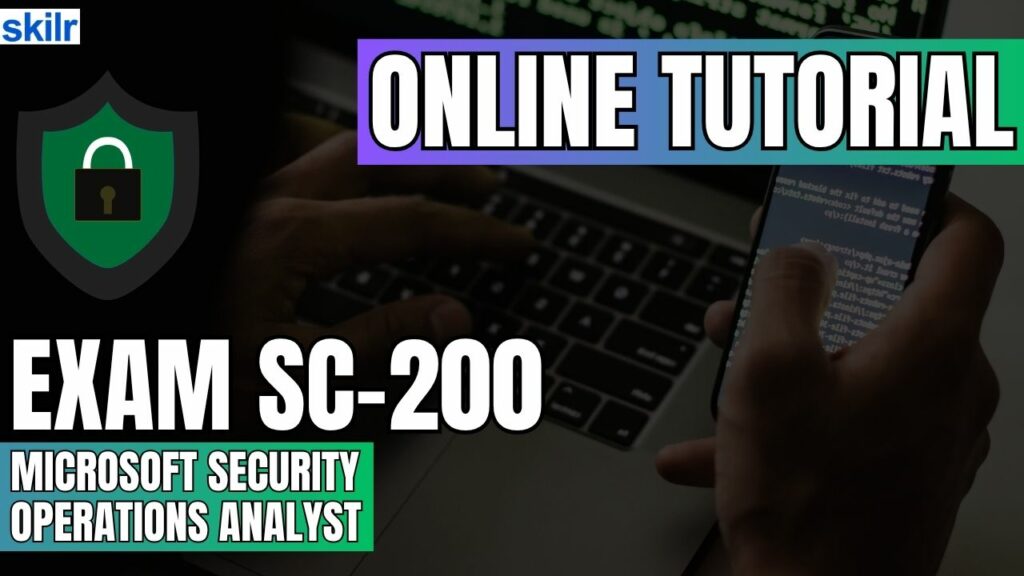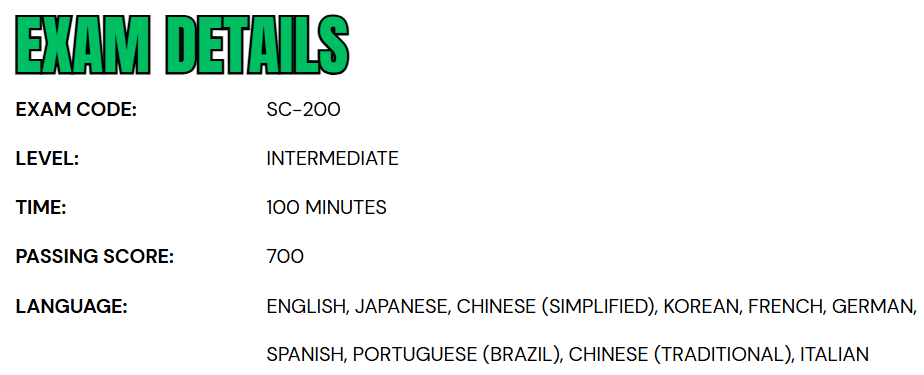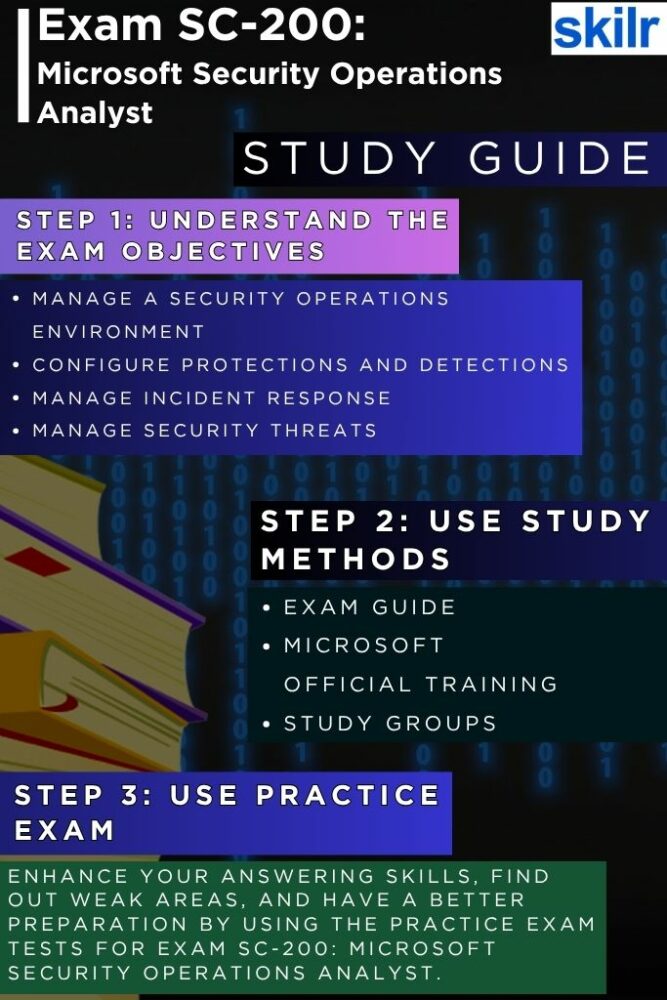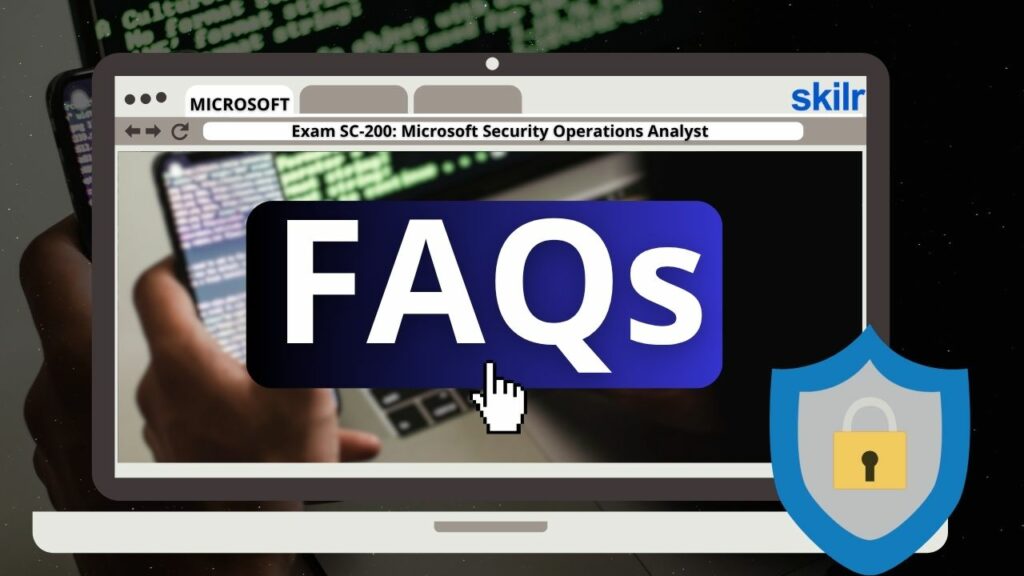
The SC-200: Microsoft Security Operations Analyst certification is designed for professionals responsible for minimizing organizational risk by actively addressing threats, monitoring security systems, and improving incident response across both cloud-based and on-premises environments. As a certified Security Operations Analyst, you play a critical role in securing your organization’s digital infrastructure. Your core responsibilities include:
- Rapid Threat Response: Quickly identify and remediate active threats affecting cloud and on-premises systems.
- Policy Enforcement: Detect and report policy violations and recommend improvements to threat protection strategies.
- Threat Hunting and Intelligence: Leverage threat intelligence to proactively hunt for vulnerabilities and indicators of compromise.
- Risk Mitigation: Employ exposure management strategies to minimize potential risks.
- Incident Management: Perform triage, respond to security incidents, and conduct thorough investigations.
- Data Querying and Reporting: Use Kusto Query Language (KQL) for threat detection, reporting, and investigation tasks.
– Security Tools and Technologies
You will use a range of Microsoft and third-party tools to monitor and respond to threats effectively, including:
- Microsoft Defender XDR
- Microsoft Sentinel
- Security Copilot
- Microsoft Defender for Cloud (Workload Protections)
- Integrated Third-Party Security Solutions
– Collaboration and Security Governance
Security operations analysts regularly collaborate with both technical teams and organizational leadership. You help define and implement company-wide security standards, support compliance, and raise security awareness across departments to enhance the overall security posture.
– Recommended Knowledge and Prerequisites
To succeed in this role and exam, candidates should have hands-on experience and a solid understanding of the following:
- Microsoft 365 security capabilities
- Azure cloud infrastructure and services
- Operating systems, including Windows, Linux, and mobile platforms
Exam Details

- The SC-200: Microsoft Security Operations Analyst exam is classified as an intermediate-level certification designed for individuals in the role of a Security Operations Analyst.
- The assessment evaluates a candidate’s ability to monitor, detect, investigate, and respond to security threats across hybrid environments using Microsoft tools and technologies.
- Candidates are given 100 minutes to complete the exam, which is proctored and may include interactive components as part of the testing experience.
- The exam is available in multiple languages, including English, Japanese, Simplified Chinese, Korean, French, German, Spanish, Brazilian Portuguese, Traditional Chinese, and Italian.
- To pass the exam, a minimum score of 700 out of 1000 is required.
- Microsoft also provides accommodations for individuals who use assistive technologies, require additional time, or need adjustments to the standard exam format. These can be requested in advance to ensure a fair and equitable testing experience.
Course Outline
The exam covers the following topics:
1. Managing a security operations environment (20–25%)
Configuring settings in Microsoft Defender XDR
- Configuring alert and vulnerability notification rules (Microsoft Documentation: Configure alert notifications in Microsoft Defender XDR)
- Configuring Microsoft Defender for Endpoint advanced features
- Configure endpoint rules settings
- Managing automated investigation and response capabilities in Microsoft Defender XDR (Microsoft Documentation: Configure automated investigation and response capabilities in Microsoft Defender XDR)
- Configuring automatic attack disruption in Microsoft Defender XDR (Microsoft Documentation: Automatic attack disruption in Microsoft Defender XDR)
Managing assets and environments
- Configuring and managing device groups, permissions, and automation levels in Microsoft Defender for Endpoint (Microsoft Documentation: Configure automated investigation and remediation capabilities in Microsoft Defender for Endpoint)
- Identifying unmanaged devices in Microsoft Defender for Endpoint
- Discover unprotected resources by using Defender for Cloud
- Identifying and remediating devices at risk by using Microsoft Defender Vulnerability Management (Microsoft Documentation: What is Microsoft Defender Vulnerability Management)
- Mitigate risk by using Exposure Management in Microsoft Defender XDR
Designing and configuring a Microsoft Sentinel workspace
- Planning a Microsoft Sentinel workspace
- Configuring Microsoft Sentinel roles (Microsoft Documentation: Roles and permissions in Microsoft Sentinel)
- Specifying Azure RBAC roles for Microsoft Sentinel configuration
- Designing and configuring Microsoft Sentinel data storage, including log types and log retention (Microsoft Documentation: Configure a data retention policy for a table in a Log Analytics workspace)
Ingesting data sources in Microsoft Sentinel
- Identifying data sources to be ingested for Microsoft Sentinel (Microsoft Documentation: Microsoft Sentinel data connectors)
- Implementing and using Content hub solutions (Microsoft Documentation: About Microsoft Sentinel content and solutions)
- Configuring and using Microsoft connectors for Azure resources, including Azure Policy and diagnostic settings (Microsoft Documentation: Connect Microsoft Sentinel to other Microsoft services by using diagnostic settings-based connections)
- Planning and configuring Syslog and Common Event Format (CEF) event collections (Microsoft Documentation: Get CEF-formatted logs from your device or appliance into Microsoft Sentinel)
- Plan and configure collection of Windows Security events by using data collection rules, including Windows Event Forwarding (WEF)
- Create custom log tables in the workspace to store ingested data
- Monitor and optimize data ingestion
2. Configuring protections and detections (15–20%)
Configuring protections in Microsoft Defender security technologies
- Configuring policies for Microsoft Defender for Cloud Apps (Microsoft Documentation: Control cloud apps with policies)
- Configuring policies for Microsoft Defender for Office 365
- Configuring security policies for Microsoft Defender for Endpoints, including attack surface reduction (ASR) rules (Microsoft Documentation: Enable attack surface reduction rules)
- Configuring cloud workload protections in Microsoft Defender for Cloud
Configuring detection in Microsoft Defender XDR
- Configuring and managing custom detections rules (Microsoft Documentation: Create and manage custom detections rules)
- Manage alerts, including tuning, suppression, and correlation (Microsoft Documentation: Investigate alerts in Microsoft Defender XDR)
- Configuring deception rules in Microsoft Defender XDR (Microsoft Documentation: Configure the deception capability in Microsoft Defender XDR)
Configuring detections in Microsoft Sentinel
- Classifying and analyzing data by using entities (Microsoft Documentation: Entities in Microsoft Sentinel)
- Configure and manage analytics rules
- Query Microsoft Sentinel data by using ASIM parsers (Microsoft Documentation: Using the Advanced Security Information Model (ASIM))
- Implementing behavioral analytics
3. Managing incident response (25–30%)
Responding to alerts and incidents in the Microsoft Defender portal
- Investigating and remediating threats by using Microsoft Defender for Office 365
- Investigating and remediating ransomware and business email compromise incidents identified by automatic attack disruption
- Investigating and remediating compromised entities identified by Microsoft Purview data loss prevention (DLP) policies
- Investigating and remediating threats identified by Microsoft Purview insider risk policies (Microsoft Documentation: Get started with insider risk management)
- Investigating and remediating alerts and incidents identified by Microsoft Defender for Cloud workload protections (Microsoft Documentation: Security alerts and incidents)
- Investigating and remediating security risks identified by Microsoft Defender for Cloud Apps (Microsoft Documentation: Investigate cloud app risks and suspicious activity)
- Investigate and remediate compromised identities that are identified by Microsoft Entra ID (Microsoft Documentation: Remediate risks and unblock users)
- Investigate and remediate security alerts from Microsoft Defender for Identity (Microsoft Documentation: Investigate Defender for Identity security alerts in Microsoft Defender XDR)
Responding to alerts and incidents identified by Microsoft Defender for Endpoint
- Investigate device timelines (Microsoft Documentation: Investigate devices in the Microsoft Defender for Endpoint Devices list)
- Performing actions on the device, including live response and collecting investigation packages
- Performing evidence and entity investigation (Microsoft Documentation: Perform evidence and entities investigations using Microsoft Defender for Endpoint)
Investigating Microsoft 365 activities
- Investigating threats by using unified audit Log (Microsoft Documentation: Investigate threats by using audit features in Microsoft Defender XDR and Microsoft Purview Standard)
- Investigate threats by using Content Search
- Investigating threats by using Microsoft Graph activity logs
Responding to incidents in Microsoft Sentinel
- Investigate and remediate incidents in Microsoft Sentinel (Microsoft Documentation: Investigate incidents with Microsoft Sentinel)
- Create and configure automation rules (Microsoft Documentation: Create and use Microsoft Sentinel automation rules to manage response)
- Run playbooks on On-premises resources
Implementing and using Microsoft Security Copilot
- Create and use promptbooks
- Manage sources for Security Copilot, including plugins and files
- Integrate Security Copilot by implementing connectors
- Managing permissions and roles in Security Copilot
- Monitor Security Copilot capacity and cost
- Identify threats and risks by using Security Copilot
- Investigating incidents by using Security Copilot
4. Managing security threats (15–20%)
Hunt for threats by using Microsoft Defender XDR
- Identifying threats by using Kusto Query Language (KQL) (Microsoft Documentation: Kusto Query Language (KQL) overview)
- Interpreting threat analytics in the Microsoft Defender portal (Microsoft Documentation: Threat analytics in Microsoft Defender XDR)
- Creating custom hunting queries by using KQL (Microsoft Documentation: Threat hunting in Microsoft Sentinel)
Hunt for threats by using Microsoft Sentinel
- Analyzing attack vector coverage by using the MITRE ATT&CK matrix (Microsoft Documentation: Understand security coverage by the MITRE ATT&CK framework)
- Manage and use threat indicators
- Create and manage hunts
- Create and monitor hunting queries
- Use hunting bookmarks for data investigations (Microsoft Documentation: Keep track of data during hunting with Microsoft Sentinel)
- Retrieve and manage archived log data (Microsoft Documentation: Restore archived logs from search)
- Create and manage search jobs (Microsoft Documentation: Search across long time spans in large datasets)
Creating and configuring Microsoft Sentinel workbooks
- Activate and customize workbook templates (Microsoft Documentation: Visualize and monitor your data by using workbooks in Microsoft Sentinel)
- Create custom workbooks that include KQL
- Configuring visualizations
Microsoft SC-200 Exam FAQs
Microsoft Certification Exam Policies
Microsoft upholds a clear and standardized set of certification exam policies designed to promote fairness, maintain exam integrity, and ensure a consistent experience for all candidates. These policies apply uniformly across all exam delivery formats, whether conducted online with remote proctoring or in-person at authorized testing centers.
– Exam Retake Policy
Candidates who do not pass a certification exam on their first attempt must wait a minimum of 24 hours before retaking it. For each subsequent retake, a 14-day waiting period is enforced. Microsoft permits a maximum of five attempts per exam within a 12-month period. Once an exam is passed, further attempts are not allowed unless recertification is required due to exam expiration. Please note that standard exam fees apply to every attempt, including all retakes.
– Rescheduling and Cancellation Policy
Exam appointments can be rescheduled or canceled at no charge if the request is made at least six business days before the scheduled exam date. Requests made within five business days may incur a rescheduling or cancellation fee. If a cancellation occurs within 24 hours of the exam time or the candidate fails to appear, the entire exam fee will be forfeited.
Microsoft SC-200 Exam Study Guide

Step 1: Understand the SC-200 Exam Objectives
Begin your preparation by thoroughly reviewing the official SC-200 exam skills outline provided by Microsoft. This document breaks down the key domains and knowledge areas covered in the exam, including threat management, incident response, and the use of Microsoft security tools like Microsoft Sentinel and Defender XDR. Pay close attention to the percentage weight assigned to each domain, as it will help you prioritize your study efforts. Understanding what the exam expects you to know is critical to creating an effective study plan.
Step 2: Use Microsoft’s Official Learning Resources
Microsoft Learn offers free, role-based learning paths specifically designed for SC-200 candidates. These modules cover all relevant topics such as incident detection, threat response, threat intelligence, and security operations. The interactive format, hands-on labs, and real-world scenarios make it easier to grasp technical concepts. It’s advisable to progress through these modules in the same order as the exam objectives, ensuring complete topic coverage and reinforcing practical knowledge with exercises and assessments. However, the modules covered are:
- Mitigating threats using Microsoft Defender XDR
- Mitigate threats using Microsoft Security Copilot
- Mitigating threats using Microsoft Purview
- Mitigating threats using Microsoft Defender for Endpoint
- Mitigating threats using Microsoft Defender for Cloud
- Creating queries for Microsoft Sentinel using Kusto Query Language (KQL)
- Configuring your Microsoft Sentinel environment
- Connecting logs to Microsoft Sentinel
- Creating detections and perform investigations using Microsoft Sentinel
- Performing threat hunting in Microsoft Sentinel
Step 3: Join Online Study Communities and Forums
Engaging with peers who are also preparing for the SC-200 exam can provide valuable insights and motivation. Online communities, such as Microsoft Tech Community, Reddit, and dedicated LinkedIn groups, allow you to ask questions, discuss difficult topics, and stay informed about changes or updates to the exam content. Learning from the experiences of others—such as which areas they found most challenging or what strategies helped them pass—can give you an edge in your own preparation.
Step 4: Take SC-200 Practice Exams and Assessments
Regular practice testing is essential for evaluating your readiness and familiarizing yourself with the exam format. Start with official practice assessments from Microsoft and then explore reputable third-party platforms offering SC-200 mock exams. These tests help you identify knowledge gaps, improve your time management skills, and build confidence under timed conditions. Review both correct and incorrect answers to understand the reasoning behind them, and revisit related topics in Microsoft Learn where necessary.
Step 5: Reinforce Your Practical Skills
The SC-200 exam evaluates your ability to apply concepts in real-world scenarios. Set up a lab environment using a Microsoft 365 trial account or Azure subscription to practice deploying and configuring tools like Microsoft Sentinel, Defender for Cloud, and Defender for Endpoint. Performing tasks such as incident triage, threat hunting, and using KQL (Kusto Query Language) for data analysis will deepen your understanding and prepare you for interactive exam components.
Step 6: Review and Revise Strategically Before the Exam
In the final stages of your preparation, focus on refining your weak areas, revisiting complex topics, and reviewing notes or flashcards you’ve created during your study sessions. Avoid cramming new topics at the last minute. Instead, allocate time for one or two full-length practice exams under timed conditions and simulate the actual exam environment as closely as possible.


